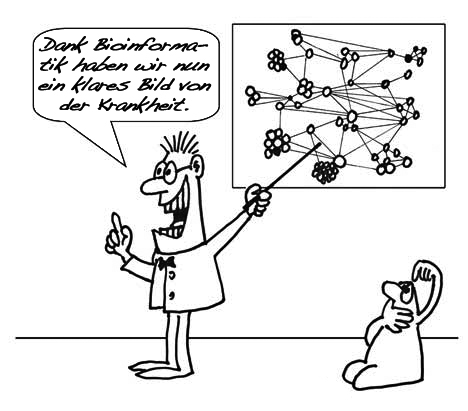 Die Bioinformatik hat nicht überall den besten Ruf. Man nehme etwa den Beitrag „Do computational biologists care about being right?„, der vor einem knappen Jahr im Blog Adaptive Complexity erschien. Darin heißt es:
Die Bioinformatik hat nicht überall den besten Ruf. Man nehme etwa den Beitrag „Do computational biologists care about being right?„, der vor einem knappen Jahr im Blog Adaptive Complexity erschien. Darin heißt es:
You have these clever computer guys, and they don’t give a damn whether their models are actually right. They’ve come up with some clever algorithm or theoretical analysis, and that’s good enough. I’m not saying that computational guys have to test everything themselves, but many of them are not even proactive about getting someone else to test them. They’re just happy to move right along to the next project that will have zero impact on biology.
Hartes Urteil. Aber nicht ganz von der Hand zu weisen, solange Dinge geschehen wie zum Beispiel das, was eine den Lab Times-Lesern wohlbekannte Eule vor einiger Zeit beschrieb. In Science hatten einige Computational Geneticists anhand von Sequenzvergleichen vorgerechnet, dass die ersten Katzenartigen frühestens vor acht Millionen Jahren auf den amerikanischen Kontinent eingewandert sein konnten. Titel ihres Papers: “The late Miocene radiation of modern felidae: A genetic assessment” (Vol. 311:73-7). Die Zunft der Paläontologen lachte sich umgehend schlapp, waren doch schon lange entsprechende ‚amerikanische‘ Fossilien bekannt und veröffentlicht, die mindestens 17 Millionen Jahre auf dem Buckel hatten.
Der bekannte US-Wissenschaftsautor Carl Zimmer schrieb ebenfalls über diesen Faux pas in PLoS Computional Biology (vol.2(12): e156):
One example of this new ambition was a paper published earlier this year on the evolution of cats. The scientists offered a sweeping scenario for cat evolution, complete with migrations of cats out of Asia into the New World and back, along with the emergence of the major groups of felids, ranging from ocelots to bobcats to lions. The scientists based their scenario entirely on an analysis of cat DNA. They did not consider a single fossil of a cat, nor did they have a paleontologist expert on cats as a coauthor. Cat fossil experts inform me that fossils of true cats as old as 17 million years have been discovered in North America. The geneticists put the arrival of cats in North America at only 8 million years ago. Whether or not the DNA results are correct, it is striking that the report does not even mention the existence of fossils that do not fit the pattern.
Und Zimmer hatte in dem Beitrag noch mehr Beispiele parat — frei nach dem Motto:
Genomes unquestionably contain a rich store of information, but sometimes that information can be deceptive.
Jetzt will es der Australier Anthony Goldbloom, CEO von Kaggle.com (einer Plattform für ‚data-mining and data-prediction competitions‘), ganz genau wissen und fragt im Kaggle-Blog ‚No Free Hunch‘:
Bis 31. Juli kann man dort Antworten und Meinungen abgeben und diskutieren. Dann entscheidet eine Jury unter allen Beiträgen über denjenigen, der die „most significant discovery“ der Bioinformatik benennt. 100 Dollar sind dafür ausgelobt. Wer macht mit?
Wir sind jedenfalls gespannt, was rauskommt.
Schlagworte: Bioinformatik, Katzen, Paläontologie, Preis, Sequenz





